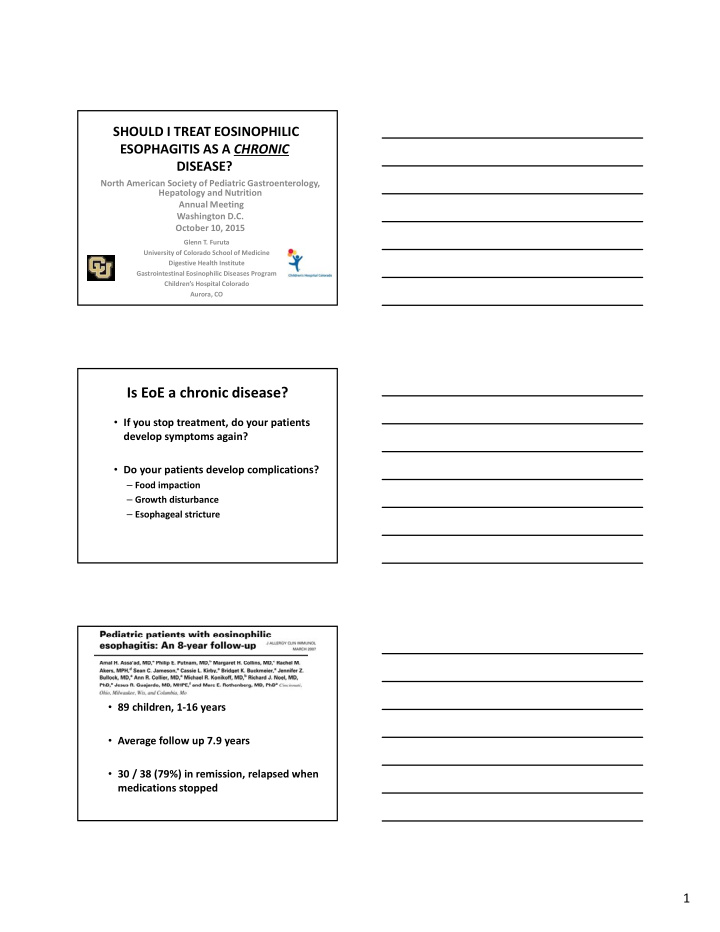



SHOULD I TREAT EOSINOPHILIC ESOPHAGITIS AS A CHRONIC DISEASE? North American Society of Pediatric Gastroenterology, Hepatology and Nutrition Annual Meeting Washington D.C. October 10, 2015 Glenn T. Furuta University of Colorado School of Medicine Digestive Health Institute Gastrointestinal Eosinophilic Diseases Program Children’s Hospital Colorado Aurora, CO Is EoE a chronic disease? • If you stop treatment, do your patients develop symptoms again? • Do your patients develop complications? – Food impaction – Growth disturbance – Esophageal stricture • 89 children, 1 ‐ 16 years • Average follow up 7.9 years • 30 / 38 (79%) in remission, relapsed when medications stopped 1
• 562 children, 1 ‐ 18 years • Average follow up 3.2 years • All patients on TCS alone, had recurrence when TCS stopped • 24 lost to follow up for 6 years, developed clinicopathological features of EoE • 53 pediatric patients followed up • 24 (45%) had abnormal dysphagia scores / difficulty swallowing • 40 (76%) were on diet restriction >65 years 2
Yes!! • Patients continue to experience disease activity, if untreated. • Patients with EoE experience diminished QoL. • Without treatment, fibrosis can occur. Yes!! • Treatment in adult EoE patients reduces food impactions. • Inflammation can lead to remodeling without overt symptoms / warning. • Disimpaction can lead to complications. No • Treatments are worse than the disease – Quality of life – Side effects • Expensive • Doesn’t matter whether you treat or not 3
Treatments are worse than the disease Caregiver Report of Food ‐ Related Stress Not at all Somewhat 40 Moderate 35 Significant 30 Severe Percent 25 20 15 10 5 0 Cost Prep Mealtime Robinson et al ‐ NASPGHAN 2015 Adrenal insufficiency? How Number of cofactors TCS Study ‐ year measured subjects Harel 2015 ACTH stim 6/14 (43%) none OVB ‐ 5 additional subjects not measured Philla 2015 cortisol 0/14 none FP, OVB Gupta 2014 cortisol 1/71 ( 1.4 %) none OVB Butz 2014 cortisol 8 of 42 (19%) high dose FP TCS Dellon 2012 cortisol 0/22 none OVB and nebulized OVB ‐ oral viscous FP ‐ fluticasone 15/163 (9%?) budesonide propionate Adrenal insufficiency is uncommon in TCS treated EoE patients – Prospective assessment of 106 children – TCS for >4 months – 28 had cortisol less <5 mcg/dl – 3 had abnormal ACTH stimulation test (3%) – All were on other topical steroid modalities Haseeb et al ‐ NASPGHAN 2015 4
Treatments are worse than the disease Expensive • Overall cost of care ‐ $3,304 / yr (no diet costs) – Diet ‐ $540 / year more expensive than regular diet • Wolf et al DDW 2015 – Drugs ‐ $600 ‐ $900 • Prior approvals • Increasingly denied Jensen et al Am J Gastroenterol 2015 Treatments are worse than the disease Doesn’t matter whether you treat or not Sherill et al Gastroenterol Clin NA 2014 Should treat! 5
Adults develop fibrosis if untreated. Dellon et al GI Endoscop 2014 Adults develop stricture if untreated. Lipka et al J Clin Gastroenterol 2015 • 200 adults with EoE • 153 men • 39 yo +/ ‐ 15 yrs 6
Adults develop fibrosis if untreated. Schoepfer et al Gastroenterol 2013 Adults develop strictures if untreated. Schoepfer et al Gastroenterol 2013 Patients experience diminished QoL* Study ‐ Year Finding Population Van Rhijn ‐ 2014 Decreased mental adult component Klinnert ‐ 2014 HRQoL Improved pediatric following treatment Harris ‐ 2013 Depression /school ‐ 69% pediatric Cortina ‐ 2010 Decreased HRQoL pediatric Klinnert ‐ 2009 Impact siblings pediatric Flood ‐ 2008 / 25 ‐ 20% Sleep disturbance pediatric Straumann ‐ 2012 and adult *teritary care studies Lynch et al Journal of Pediatric Psychology 2015 7
• 206 subjects • 5 year follow up • 33 patients with FI (42 impactions) • Univariate logistic regression modeling to assess for contributing factors Treatment reduces food impactions. Kuchen et al Allergy 2014 • 32 children from a 10 year span • Treated with TCS for 4.5 years • 738 biopsies from 246 procedures • Identified responders (R) and non ‐ responders (NR) 8
Endoscopic evidence of remodeling Histologic evidence of remodeling Remodeling is worse when inflammation persists. 9
Esophageal dysmotility increases with disease duration. Van Rhijn et al Neurogastroenterol Motil 2015 Esophagrams may be better than endoscopy to detect narrowing in EoE Gentile et al APT 2015 Menard ‐ Katcher et al JPGN 2015 Philosophy of “monitoring” disease activity • Growth and development • Balance of treatment risks and benefits with QOL and symptom control • Bring tissue to “remission” 10
www.rarediseasesnetwork.org/cms/CEGIR 11
Recommend
More recommend